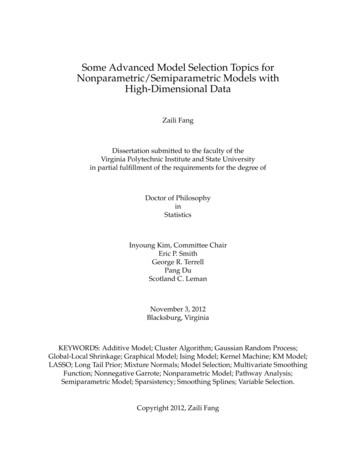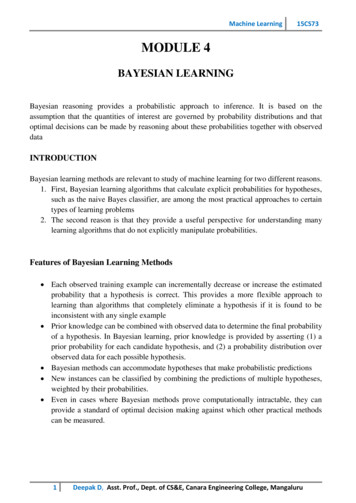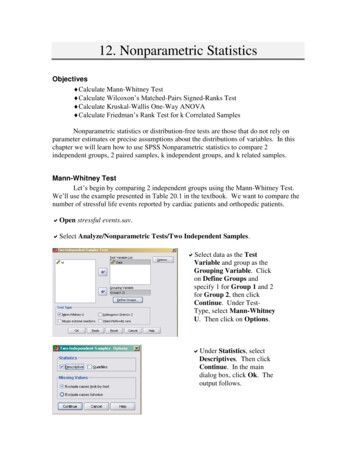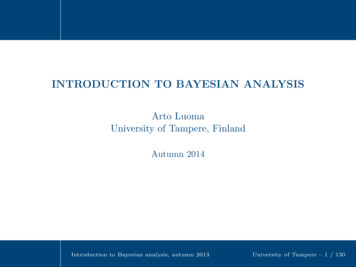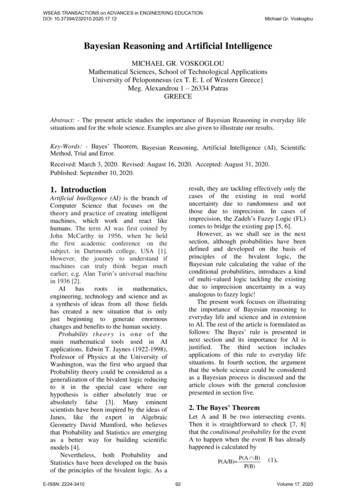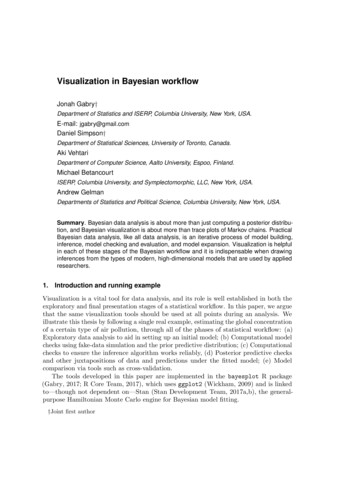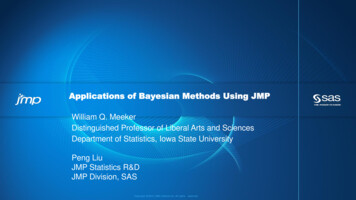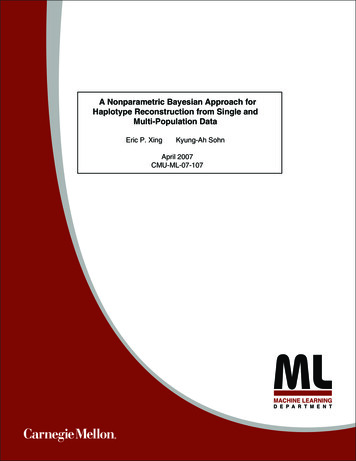
Transcription
A Nonparametric Bayesian Approach forHaplotype Reconstruction from Single andMulti-Population DataEric P. XingKyung-Ah SohnApril 2007CMU-ML-07-107
A Nonparametric Bayesian Approach forHaplotype Reconstruction from Single andMulti-Population DataEric P. XingKyung-Ah SohnApril 2007CMU-ML-07-107School of Computer ScienceCarnegie Mellon UniversityPittsburgh, PA 15213AbstractUncovering the haplotypes of single nucleotide polymorphisms and their population demography is essential for many biological and medical applications. Methods for haplotype inferencedeveloped thus far –including those based on approximate coalescence, finite mixtures, and maximal parsimony– often bypass issues such as unknown complexity of haplotype-space and demographic structures underlying multi-population genotype data. In this paper, we propose a newclass of haplotype inference models based on a nonparametric Bayesian formalism built on theDirichlet process, which represents a tractable surrogate to the coalescent process underlying population haplotypes and offers a well-founded statistical framework to tackle the aforementionedissues. Our proposed model, known as a hierarchical Dirichlet process mixture, is exchangeable,unbounded, and capable of coupling demographic information of different populations for posterior inference of individual haplotypes, the size and configuration of haplotype ancestor pools,and other parameters of interest given genotype data. The resulting haplotype inference program,Haploi, is readily applicable to genotype sequences with thousands of SNPs, at a time-cost oftentwo-orders of magnitude less than that of the state-of-the-art PHASE program, with competitiveand sometimes superior performance. Haploi also significantly outperforms several other extantalgorithms on both simulated and realistic data.
Keywords: haplotype inference, Dirichlet Process, Hierarchical Dirichlet process, mixturemodel, population genetics
1IntroductionRecent experimental advances have led to an explosion of data which document genetic variation atthe DNA level within and between populations. For example, the international SNP map workinggroup Group 1 has reported the identification and mapping of 1.4 million single nucleotide polymorphisms (SNPs) from the genomes of 4 different human populations in the world. These kindsof data lead to challenging inference problems whose solutions could lead to greater understandingof the genetic basis of disease propensities and other complex traits 2,3 .SNPs represent the largest class of individual differences in DNA. A SNP refers to the existence of two specific nucleotides chosen from {A, C, G, T } at a single chromosomal locus in apopulation; each variant is called an allele. A haplotype refers the joint allelic identities of a list ofSNPs at contiguous sites in a local region of a single chromosome. Assuming no recombination inthis local region, a haplotype is inherited as a unit. For diploid organisms (such as humans), eachindividual has two physical copies of each chromosome (except for the Y chromosome) in his/hersomatic cells; one copy is inherited from the mother, and the other from the father. Thus duringeach generation of inheritance when chromosomes come in pairs, two haplotypes, for example,h1 (1, 1, 0, 0) and h2 (0, 0, 1, 1) of a 4-loci region, go together to make up a genotype, whichis the list of unordered pairs of alleles in the attendant region, e.g., g (1/0, 1/0, 1/0, 1/0) in caseof the aforementioned two haplotypes. That is, a genotype is obtained from a pair of haplotypesby omitting the specification of the association of each allele with one of the two chromosomes—its phase. Indeed, phase is in general ambiguous when only the genotypes of a SNPs sequenceare given 4,5 . For example, in the above example, given the g, an alternative configuration of thehaplotypes, h01 (1, 1, 1, 1) and h02 (0, 0, 0, 0), is also consistent with the genotype; but observing multiple genotypes in a population can help to bias the phase reconstruction toward thetrue haplotypes. The problem of inferring SNP haplotypes from genotypes is essential for theunderstanding of genetic variations and linkage disequilibrium patterns in a population. For example, accurate inferences concerning population structures or quantitative trait locus maps usuallydemand the analysis of the genetic states of possibly non-recombinant segments of the subject’schromosome(s) 6 . Thus, it is advantageous to study haplotypes, which consist of several closelyspaced (hence linked) phase-known SNPs and often prove to be more powerful discriminators ofgenetic variations within and among populations.Common biological methods for assaying genotypes typically do not provide phase information for individuals with heterozygous genotypes at multiple autosomal loci; phase can be obtainedat a considerably higher cost via molecular haplotyping 7 . In addition to being costly, these methods are subject to experimental error and are low-throughput. Alternatively, phase can also beinferred from the genotypes of a subject’s close relatives 5 . But this approach is often hampered bythe fact that typing family members increases the cost and does not guarantee full informativeness.It is desirable to develop automatic and robust in silico methods for reconstructing haplotypes fromgenotypes and possibly other data sources (e.g., pedigrees).Key to the inference of individual haplotypes based on a given genotype sample, is the formulation and tractability of the marginal probability of the haplotypes of a study population. Considerthe set of haplotypes, denoted as H {h1 , h2 , . . . , h2n } (where hi P T , P denotes the allelespace of the polymorphic markers and T denotes the length of the marker sequence), of a random1
sample of 2n chromosomes of n individuals taken from a population at stationarity of some inheritance process, e.g., an infinitely-many-allele (IMA) mutation model. Under common geneticarguments, the ancestral relationships amongst the sample back to its most recent common ancestor(MRCA) can be described by a genealogical tree, and computing p(H) involves a marginalizationover all possible genealogical trees consistent with the sample, which is widely known to be intractable. As discussed in Stephens and Donnelly 8 , write P (H) as a product of conditionals basedon the chain rule, i.e.,P (h1 , h2 , . . . , h2n ) P (h1 )P (h2 h1 ) . . . P (h2n h1 . . . h2n 1 ),(1)then the generation of a haplotype sample H can be viewed as a sequential process that drawone haplotype at a time conditioning on all the previously drawn haplotypes, e.g., by introducing random mutations to the latter. (This is equivalent to sampling from a genealogy evolvingin non-overlapping generations.) Therefore, one can develop tractable approximation to P (H)by appropriately approximating the conditionals in Eq. (1). Stephens and Donnelly 8 suggestedan approximation to P (hi h1 . . . hi 1 ) that captures, among several desirable genetic properties,the parental-dependent-mutation (PAM) property , by modeling hi as the progeny of a randomlychosen existing haplotype through a geometric-distributed number of mutations. This model, referred to as the PAC (for Product of Approximate Conditionals) model, forms the basis of thePHASE program 9 , which has set the state-of-the-art benchmarks in haplotype inference.However, one caveat of the PAC model, as acknowledged in Li and Stephens 10 , is that it implicitly assumes existence of an ordering in the haplotype sample, therefore the resulting likelihooddoes not enjoy the property of exchangeability that we would expect to be satisfied by the truep(H). Although empirically this pitfall appears to be inconsequential after some heuristic averaging over a moderate number of random orderings, it is difficult to associate this approximation to anexplicit assumption about the population demography and genealogy underlying the sample. Forexample, the genealogy of haplotypes with possibly common ancestry is replaced by asymmetricpairwise relationships (induced by the conditional mutation model) between the haplotypes. Theresulting “flattening” of the latent genealogical history makes it difficult to use the PAC method todiscover and exploit latent demographic structures such as estimating the number and pattern ofprototypical haplotypes (i.e., founders), which may be indicative of genetic bottlenecks and divergence time of the study population, or to make use of the ethnic identities of the sample to improvehaplotyping accuracy in multi-population haplotype inference.The finite mixture models adopted by programs such as HAPLOTYPER represent anotherclass of haplotype models that rely very little on demographic and genetic assumptions of thesample 11–14 . Under such a model, haplotypes are treated as latent variables associated with specificfrequencies, and the probability of a genotype is given by:Xp(g) p(h1 , h2 )f (g h1 , h2 ),(2)h1 ,h2 H The parental-dependent-mutation posit that, in a sequential generation process of haplotypes, if the next haplotypedoes not match exactly with an existing haplotype, it will tend to differ by a small number of mutations from an existingone, rather than be completely different.2
where f (g h1 , h2 ) is a noisy channel relating the observed genotype to the unobserved true underlying haplotypes† , and H denote the set of all possible haplotypes of a given region. Under theassumption of Hardy-Weinberg equilibrium (HWE), an assumption that is standard in the literatureand will also be made here, the mixing proportion p(h1 , h2 ) is assumed to factor as p(h1 )p(h2 ).Given this basic statistical structure, the haplotype inference problem can be viewed a missingvalue inference and parameter estimation problem. Numerous statistical models and statisticalinference approaches have been developed for this problem, such as the maximum likelihood approaches via the EM algorithm 11,15–17 , and a number of parametric Bayesian inference methodsbased on Markov Chain Monte Carlo (MCMC) techniques 12,14 .The finite mixture model defines an exchangeable P (H). But since such models are data-drivenrather than genetically motivated, they offer no insight of the genealogical history underlying thesample. Furthermore, these methodologies have rather severe computational requirements in thata probability distribution must be maintained on a (large) set of possible haplotypes. Indeed, thesize of the haplotype pool, which reflects the diversity of the genome and its evolutionary history,is unknown for any given population data; thus we have a mixture model problem in which a keyaspect of the inferential problem involves inference over the number of mixture components, i.e.,the haplotypes. There is a plethora of combinatorial algorithms based on various deterministic hypothesis such as the “parsimony” principles that offer control over the complexity of the inferenceproblem 4,18–20 , and these methods have demonstrated effectiveness in certain settings and providedimportant insights to the problem (see Gusfield 21 for an excellent survey). But compared to thestatistical approaches, they offer less flexibility and/or scalability in handling missing value, typingerror, evolution modeling and more complex scenarios on the horizon in haplotype modeling (e.g.,recombinations, genetic mapping, etc.). Most current statistical methods for haplotype inferencebypass the issue of ancestral-space uncertainty via an ad hoc specification of the number of haplotypes needed to account for the given genotypes. Although certain coalescent-based models 14 ormodel-selections methods can partially address these issues.Besides the ancestral-space uncertainty issue discussed above, the haplotype models developedso far are still limited in their flexibility and are inadequate for addressing many realistic problems.Consider for example a genetic demography study, in which one seeks to uncover ethnic- and/orgeographic-specific genetic patterns based on a sparse census of multiple populations. In particular,suppose that we are given a sample that can be divided into a set of subpopulations; e.g., African,Asian and European. We may not only want to discover the sets of haplotypes within each subpopulation, but we may also wish to discover which haplotypes are shared between subpopulations,and what are their frequencies. Empirical and theoretical evidence suggests that an early split ofan ancestral population following a populational bottleneck (e.g., due to sudden migration or environmental changes) may lead to ethnic-group-specific populational diversity, which features bothancient haplotypes (that have high variability) shared among different ethnic groups, and modernhaplotypes (that are more strictly conserved) uniquely present in different ethnic groups 22 . Thisstructure is analogous to a hierarchical clustering setting in which different groups comprising†A prevalent form of f in the literature is f I(h1 h2 g), which is a deterministic indicator function of theevent that haplotypes h1 and h2 are consistent with g. More desirable forms of f would model errors in the genotypingor data recording process, a point we will return to later in the paper.3
multiple clusters may share clusters with common centroids.In this paper, we describe a new class of haplotype inference models based on a nonparametricBayesian formalism built on the Dirichlet process (DP) 23,24 , which offers a well-founded statisticalframework to tackle the problems discussed above more efficiently and accurately. As we discussin the sequel, the Dirichlet process can induce a partition of an unbounded population in a waythat is closely related to the Ewens sampling formula 25 , thus it can be viewed as an exchangeableapproximation to the joint distribution of population haplotypes under a coalescent process. Onthe other hand, in the setting of mixture models, the Dirichlet process is able to capture uncertainty about the number of mixture components 26 . A hierarchical extension of DP also leads toan elegant model that couples the demographic information in different populations for solvingmulti-population haplotype inference problems.Our model differs from the extant models in the following important ways: 1) Instead of resorting to ad hoc parametric assumptions or model selection over the number of population haplotypes,as in many parametric Bayesian models, we introduce a nonparametric prior over haplotypes ancestors, which facilitates posterior inference of the haplotypes (and other genetic properties of interest) in an “open” state space that can accommodate arbitrary sample size. 2) Our model capturessimilar genetic features as those emphasized in Stephens et al. 9 , including the parent-dependentmutation property, but with an exchangeable likelihood function rather than an order-dependentone as in the PAC model. 3) The hierarchical Bayesian framework of our model explicitly capturesancestral/population structures and incorporates demographic/genetic parameters so that they canbe inferred or estimated along with the haplotype phase based on given genotype data. 4) Ourmodel can explicitly exploit the ethnic labels, and potentially latent sub-population structures ofthe sample, to improve haplotyping accuracy. Some fragments of the technical aspects of the proposed model was announced before in conferences in the machine learning community 27,28 , but toour knowledge the full statistical model and its population genetic interpretations are new to thegenetics community, and a computer program based on this model for haplotype reconstructionfrom large genotype data is not yet available. In this paper, we describe this new nonparametric Bayesian approach for haplotype modeling in detail, and we present an efficient Monte Carloalgorithm, Haploi, for haplotype inference based on the proposed model, which is readily applicable to genotype sequences with thousands of SNPs, at a time-cost often at least two-orders ofmagnitude less than that of the state-of-the-art PHASE program, with competitive and sometimessuperior performance (mostly in long sequences). We also show that Haploi significantly outperforms several other extant haplotype inference algorithms on both simulated and realistic data. AC implementation of Haploi can be obtained from the authors via email request, and will besoon made public on world wide web once interface and GUI development are completed.2The Statistical ModelAs motivated in the introduction, it is desirable to explicitly explore the demographic characteristics such as population structure and ethnic label, and the genetic scenarios such as coalescenceand mutation, underlying the study populations, while performing haplotype inference on complexpopulation samples. In the following, we present two novel nonparametric Bayesian models for4
haplotype inference that facilitate this desire. We begin with a basic model for the simplest demographic and genetic scenario, in which we ignore individual ethnic labels in the sample (as inmost extant haplotyping methods), and assume absence of recombination in the sample. Then wegeneralize this model to a multi-population scenario. Finally we deal with long genotypes withrecombinations with an algorithmic approach motivated by the partition-ligation scheme 12 .2.12.1.1A Dirichlet process mixture model for haplotypesDirichlet process mixtureGiven a sample of n chromosomes, under neutrality and random-mating assumptions, the distribution of the genealogy trees of the sample can be approximated by that of a random tree known asthe n-coalescent 29 . Additionally, on each lineage there is a point process of mutation events. Thebest understood, and also the simplest instances of such mutation processes is the infinitely-manyalleles (IMA) model, in which each mutation in the lineage produces a novel type, independentof the parental allele. IMA can be understood as an independent Poisson process with rate, say,α/2, which is determined by the size of the evolving population N (usually N n) and the pergeneration mutation rate µ (i.e., α 4N µ). Although easy to analyze, IMA is unrealistic becauseit fails to capture dependencies among haplotypes. On the other hand, to date no closed-form expression of P (H) is known for the more realistic parent-dependent mutation (PDM) model underthe n-coalescent; approximations such as the PAC model has been used as a tractable surrogate.In the sequel, we describe an alternative approach for modeling P (H) based on a nonparametric Bayesian formalism known as the Dirichlet process, which leads to a new class of modelsfor haplotype distribution that approximately captures major properties that would result from acoalescent-with-PDM model.We begin with a brief genetic motivation of the proposed approach. Rather than focusingon a complete random genealogy up to the MRCA, we instead consider a sample of n individuals from a population characterized by an unknown set of founding haplotypes, with unknownfounder frequencies. For now we focus attention on a small chromosomal region within which thepossibility of recombination over relevant time-scales is negligible. As a consequence, we postulate that each individual’s genotype is formed by drawing two random haplotype founders from anancestral pool, one for each of the two actual haplotypes of this individual, which can be mutatedversion of their corresponding founders. We further assume that we are given noisy observationsof the resulting genotypes. Below we show how this setting relates to the coalescent-with-IMA andcoalescent-with-PDM models.Under Kingman’s coalescent-with-IMA model, one can treat a haplotype from a modern individual as a descendent of a most resent common ancestor with unknown haplotype via randommutations that alter the allelic states of some SNPs 29 . Hoppe 30 observed that a coalescent process in an infinite population leads to a partition of the population at every generation that can besuccinctly captured by the following Pólya urn scheme.Consider an urn that at the outset contains a ball of a single color. At each step we eitherdraw a ball from the urn and replace it with two balls of the same color, or we are given a ballof a new color which we place in the urn. One can see that such a scheme leads to a partition of5
the balls according to their color. Mapping each ball to a haploid individual and each color to apossible haplotype, this partition is equivalent to the one resulted from the coalescence-with-IMAprocess 30 , and the probability distribution of the resulting allele spectrum—the numbers of colors(i.e., haplotypes) with every possible number of representative balls (i.e., decedents)—is capturedby the well-known Ewens’ sampling formula 25 .Letting parameter α define the probabilities of the two types of draws in the aforementionedPólya urn scheme, and viewing each (distinct) color as a sample from Q0 , and each ball as a sample from Q, Blackwell and MacQueen 24 showed that this Pólya urn model yields samples whosedistributions are those of Q0 the marginal probabilities under the Dirichlet process 23 . Formally,a random probability measure Q is generated by a DP if for any measurable partition A1 , . . . , Akof the sample space (e.g., the partition of an unbounded haploid population according to common haplotype patterns), the vector of random probabilities Q(Ai ) follows a Dirichlet distribution:(Q(A1 ), . . . , Q(Ak )) Dir(αQ0 (A1 ), . . . , αQ0 (Ak )), where α denotes a scaling parameter andQ0 denotes a base measure. The Pólya urn construction of DP makes explicit an order-independentsequential sampling scheme to draw samples from a DP. Specifically, having observed n sampleswith values (φ1 , . . . , φn ) from a Dirichlet process DP (α, Q0 ), the distribution of the value of the(n 1)th sample is given by:φn 1 φ1 , . . . , φn , α, Q0 KXαnkδφ k (·) Q0 (·),n αn αk 1(3)where δφ k (·) denotes a point mass at a unique value φ k , nk denotes the number of samples withvalue φ k , and K denotes the number of unique values in the n samples drawn so far. This conditional distribution is useful for implementing Monte Carlo algorithms for haplotype inferenceunder DP-based models. We will return to this point in the Appendix.Under a DP distribution described above, the sampled haplotypes follow an IMA model, meaning that all different haplotypes (i.e., ball colors) are independent. How can we take into consideration the fact that, in a real haplotype sample one would expect that some haplotypes differ onlyslightly (i.e., at a few SNP loci) whereas some differ much more significantly—a phenomenoncaused by possibly parent-dependent mutations. Now we describe a DP mixture (DPM) modelthat approximate this effect.In the context of mixture models, one can associate common data centroids, i.e., haplotypefounders rather than all distinct haplotypes, with colors drawn from the Pólya urn model andthereby define a “clustering” of the (possibly noisy) data {hi } (e.g., modern haplotypes that are“recognizable” variants of their corresponding founders) via likelihood function p(hi φi ). As obvious from Eq. (3), the samples (i.e., ball-draws) {φi } from a DP (i.e., the urn) tend to concentratethemselves around some unique values {φ k } (i.e., colors); thus conditioning on each such uniquevalue φ k , we have a mixture component p(hi φ k ) for the data. Such a mixture model is knownas the DP mixture 26,31 . Note that a DP mixture requires no prior specification of the number ofcomponents, which is typically unknown in genetic demography problems. It is important to emphasize that here DP is used as a prior distribution of mixture components. Multiplying this priorby a likelihood that relates the mixture components to the actual data yields a posterior distribution of the mixture components, and the design of the likelihood function is completely up to the6
modeler based on specific problems. This nonparametric Bayesian formalism forms the technicalfoundation of the haplotype modeling and inference algorithms to be developed in this paper.2.1.2DPM for haplotype inferenceNow we briefly recapitulate the basic DPM for haplotypes first proposed in Xing et al. 27 . In the nextsection we generalize this model to multi-population haplotypes, and describe specific Bayesiantreatments of all relevant model parameters.Write Hie [Hie ,1 , . . . , Hie ,T ], where the sub-subscript e {0, 1} denotes the two possibleparental origins (i.e., paternal and maternal), for a haplotype over T contiguous SNPs from individual i; and let Gi [Gi,1 , . . . , Gi,T ] denote the genotype these SNPs of individual i. For diploidorganisms such as human, we denote the two alleles of a SNP by 0 and 1; thus each Gi,t can take onone of four values: 0 or 1, indicating a homozygous site; 2, indicating a heterozygous site; and ’?’,indicating missing data. (A generalization to polymorphisms with k-ary alleles is straightforward,but omitted here for simplicity.) Let Ak [Ak,1 , . . . , Ak,T ] denote an ancestor haplotype (indexedby k) and θk denote the mutation rate of ancestor k; and let Ci denote an inheritance variable thatspecifies the ancestor of haplotype Hi . We write Ph (H A) for the inheritance model accordingto which individual haplotypes are derived from a founder, and Pg (G H0 , H1 ) for the genotypingmodel via which noisy observations of the genotypes are related to the true haplotypes. Under aDP mixture, we have the following Pólya urn scheme for sampling the genotypes, Gi , i 1, . . . , n,of a sample with n individuals: Draw first haplotype:a1 , θ1 DP(τ, Q0 ) Q0 (·), sample the 1st founder (and its associated mutation rate);h1 Ph (· a1 , θ1 ),sample the 1st haplotype from an inheritance model defined on the 1stfounder; for subsequent haplotypes:– sample the founder indicator for the ith haplotype:ci DP(τ, Q0 ) p(ci cj for some j i c1 , . . ., ci 1 ) p(c 6 c for all j i c , . . ., c ) ij1i 1ncji 1 ααi 1 αwhere nci is the occupancy number of class ci —the number of previous samples generatedfrom founder aci .– sample the founder of haplotype i (indexed by ci ): {acj , θcj } if ci cj for some j i (i.e., ci refers to an inheritedfounder)φci DP(τ, Q0 ) Q (a, θ) if c 6 c for all j i (i.e., c refers to a new founder)iji07
– sample the haplotype according to its founder:hi ci Ph (· aci , θci ). sample all genotypes (according to a one-to-one mapping between haplotype index i and allele indexie ):gi hi0 , hi1 Pg (· hi0 , hi1 ).Under appropriate parameterizations of the base measure Q0 , the inheritance model Ph , and thegenotyping model Pg , which will be described in detail shortly, the problem of phasing individualhaplotypes and estimating the size and configuration of the latent ancestral pool under a DPMmodel can be solved via posterior inference given the genotypes from a (presumably ethnicallyhomogeneous) population descending from a single pool of ancestors, using, for example, a Gibbssampler as we will outline in the Appendix.As mentioned earlier, treating haplotype distribution as a mixture model, where the set ofmixture components correspond to the pool of ancestral haplotypes, or founders, of the population,can be justified by straightforward statistical genetics arguments. Crucially, however, the size ofthis pool is unknown; indeed, knowing the size of the pool would correspond to knowing somethingsignificant about the genome and its history. In most practical population genetic problems, usuallythe detailed genealogical structure of a population (as provided by the coalescent trees) is of lessimportance than the population-level features such as pattern of common ancestor alleles (i.e.,founders) in a population bottleneck, the age of such alleles, etc. In this case, the DP mixture offersa principled approach to generalize the finite mixture model for haplotypes to an infinite mixturemodel that models uncertainty regarding the size of the ancestor haplotype pool, and at the sametime it provides a reasonable approximation to the coalescence-with-PDM model by utilizing thepartition structure resulted thereof, but allowing further mutations within each partite to introducefurther diversity among descents of the same founder.2.2A Hierarchical DP mixture model for multi-population haplotypesNow we consider the case in which there exist multiple sample populations (e.g., ethnic groups),each modeled by a distinct DP mixture. Note that now we have multiple ancestor pools, one foreach attendant population; instead of modeling these populations independently, we place all thepopulation-specific DPMs under a common prior, so that the ancestors (i.e., mixture components)in any of the population-specific mixtures can be shared across all the mixtures, but the weight ofan ancestral haplotype in each mixture is unique. Genetically, this means that for every possibleancestral haplotype, it can either be a founder in only one of the populations, or be a founder sharedin some or all attendant populations; in the latter case, the frequencies of this haplotype founderbeing inherited are different in different populations.To tie population-specific DP mixtures together in this way, we use a hierarchical DP mixturemodel 32 , in which the base measure associated with each population-specific DP mixture is itselfdrawn from a higher-level Dirichlet process DP(γ, F ). Since a draw from this higher-level DPis a discrete measure with probability 1, atoms drawn by different population-specific DPs fromDP(γ, F )—the haplotype founders and its mutation rate φk {Ak , θk }, which are used as the8
mixture components in each of the population-specific DP mixtures—are not going to be all distinct (i.e., the same (Ak , θk ) can be drawn by two different populatio
then the generation of a haplotype sample H can be viewed as a sequential process that draw one haplotype at a time conditioning on all the previously drawn haplotypes, e.g., by introduc-ing random mutations to the latter. (This is equivalent to sampling from a genealogy evolving in non-overlapping generations.)

